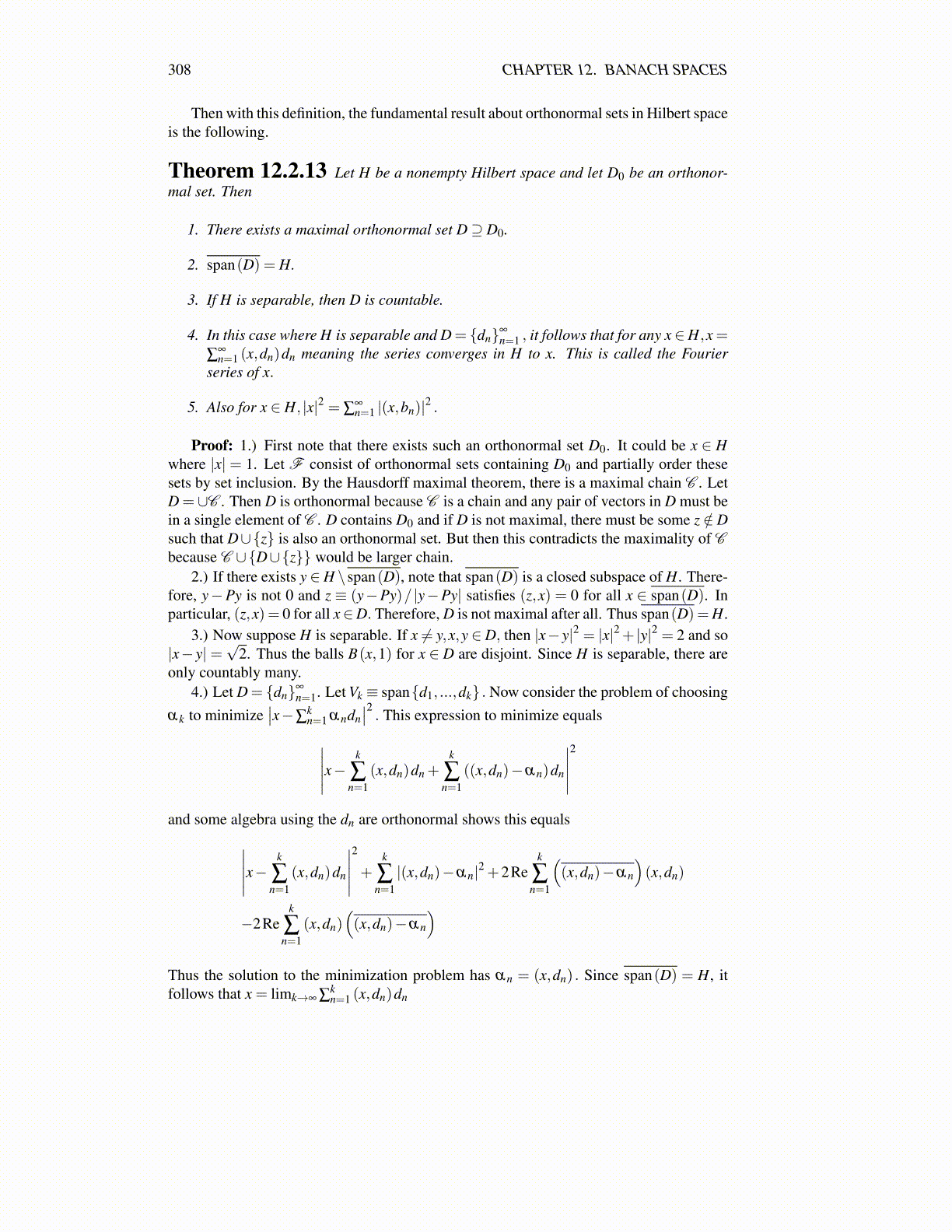
308 CHAPTER 12. BANACH SPACES
Then with this definition, the fundamental result about orthonormal sets in Hilbert spaceis the following.
Theorem 12.2.13 Let H be a nonempty Hilbert space and let D0 be an orthonor-mal set. Then
1. There exists a maximal orthonormal set D⊇ D0.
2. span(D) = H.
3. If H is separable, then D is countable.
4. In this case where H is separable and D = {dn}∞
n=1 , it follows that for any x∈H,x =∑
∞n=1 (x,dn)dn meaning the series converges in H to x. This is called the Fourier
series of x.
5. Also for x ∈ H, |x|2 = ∑∞n=1 |(x,bn)|2 .
Proof: 1.) First note that there exists such an orthonormal set D0. It could be x ∈ Hwhere |x| = 1. Let F consist of orthonormal sets containing D0 and partially order thesesets by set inclusion. By the Hausdorff maximal theorem, there is a maximal chain C . LetD = ∪C . Then D is orthonormal because C is a chain and any pair of vectors in D must bein a single element of C . D contains D0 and if D is not maximal, there must be some z /∈Dsuch that D∪{z} is also an orthonormal set. But then this contradicts the maximality of Cbecause C ∪{D∪{z}} would be larger chain.
2.) If there exists y ∈H \ span(D), note that span(D) is a closed subspace of H. There-fore, y−Py is not 0 and z ≡ (y−Py)/ |y−Py| satisfies (z,x) = 0 for all x ∈ span(D). Inparticular, (z,x) = 0 for all x∈D. Therefore, D is not maximal after all. Thus span(D) =H.
3.) Now suppose H is separable. If x ̸= y,x,y ∈D, then |x− y|2 = |x|2 + |y|2 = 2 and so|x− y|=
√2. Thus the balls B(x,1) for x ∈ D are disjoint. Since H is separable, there are
only countably many.4.) Let D = {dn}∞
n=1. Let Vk ≡ span{d1, ...,dk} . Now consider the problem of choosingαk to minimize
∣∣x−∑kn=1 αndn
∣∣2 . This expression to minimize equals∣∣∣∣∣x− k
∑n=1
(x,dn)dn +k
∑n=1
((x,dn)−αn)dn
∣∣∣∣∣2
and some algebra using the dn are orthonormal shows this equals∣∣∣∣∣x− k
∑n=1
(x,dn)dn
∣∣∣∣∣2
+k
∑n=1|(x,dn)−αn|2 +2Re
k
∑n=1
((x,dn)−αn
)(x,dn)
−2Rek
∑n=1
(x,dn)((x,dn)−αn
)Thus the solution to the minimization problem has αn = (x,dn) . Since span(D) = H, itfollows that x = limk→∞ ∑
kn=1 (x,dn)dn